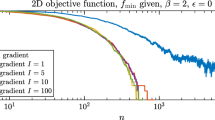Abstract
A formal analysis of so-called diffusion algorithms is performed. They are frequently used in structural recognition but are rather poorly theoretically studied. These algorithms are analyzed from the viewpoint of their ability to optimize a function of many discrete variables, which is represented as the sum of many terms each of which depends on only two variables. It is proved that, under some stop condition, a diffusion algorithm approximately solves certain subclasses of optimization problems with any predefined nonzero error. The totality of problems solved by diffusion algorithms includes all so-called acyclic and supermodular optimization problems and also some other problems for which solution algorithms are unknown.
Similar content being viewed by others
References
M. I. Shlezinger, “Syntactic analysis of two-dimensional visual signals in the presence of noise,” Cybernetics, Vol. 12, No. 4, 612–628 (1976).
V. Kolmogorov, “Convergent tree-reweighted message passing for energy minimization,” IEEE Trans. on Pattern Analysis and Machine Intelligence (PAMI), 28, No. 10, 1568–1583 (2006).
Y. Boykov, O. Veksler, and R. Zabih, “Fast approximate energy minimization via graph cuts,” IEEE Trans. on Pattern Analysis and Machine Intelligence (PAMI), 23, No. 11, 1222–1239 (2001).
M. I. Schlesinger and B. Flach, “Some solvable subclasses of structural recognition problems,” in: Czech Pattern Recognition Workshop, Praha (2000), pp. 55–62.
M. I. Sñhlesinger and V. V. Giginyak, “Solution to structural recognition (max,+)-problems by their equivalent transformations. I,” Control Systems and Machines, No. 1, 3–15 (2007).
M. I. Sñhlesinger and V. V. Giginyak, “Solution to structural recognition (max,+)-problems by their equivalent transformations. II,” Control Systems and Machines, No. 2, 5–17 (2007).
T. Werner, “A linear programming approach to max-sum problem: A review,” IEEE Trans. on Pattern Analysis and Machine Intelligence (PAMI), 29, No. 7, 1165–1179 (2007).
D. Schlesinger, “Exact solution of permuted submodular minsum problems,” in: A. L. Yuille et al. (Eds.), CVPR (2007), pp. 28–38.
G. M. Fikhtengol’ts, A Course of Differential and Integral Calculus [in Russian], Fizmatgiz, Moscow, Vol. 1 (2001).
V. K. Koval and M. I. Schlesinger, “Two-dimensional programming in image analysis problems,” Avtomat. Telemekh., No. 8, 149–168 (1976).
H. Ishikawa and D. Geiger, “Segmentation by grouping junctions,” in: IEEE Conf. Comp. Vision and Pattern Recogn. (1998), pp. 125–131.
M. Schlesinger and V. Glavach, Ten Lectures on Statistical and Structural Recognition [in Russian], Naukova Dumka, Kyiv (2004).
M. Wainwright, T. Jaakkola, and A. Willsky, “Exact MAP estimates by (hyper) tree agreement,” in: S. T. S. Becker and K. Obermayer (eds.), Advances in Neural Information, Processing Systems 15, MIT Press (2003), pp. 809–816.
Author information
Authors and Affiliations
Corresponding author
Additional information
Translated from Kibernetika i Sistemnyi Analiz, No. 2, pp. 3–20, March–April 2011.
Rights and permissions
About this article
Cite this article
Schlesingera, M.I., Antoniuka, K.V. Diffusion algorithms and structural recognition optimization problems. Cybern Syst Anal 47, 175–192 (2011). https://doi.org/10.1007/s10559-011-9300-z
Received:
Published:
Issue Date:
DOI: https://doi.org/10.1007/s10559-011-9300-z




